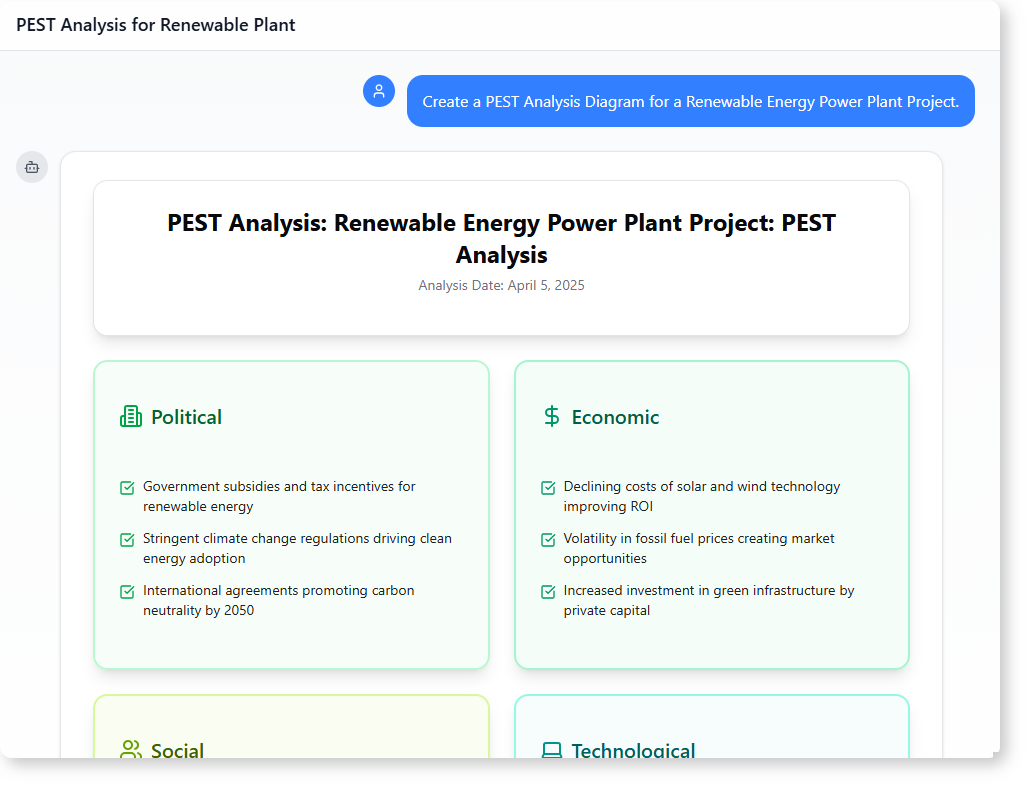Now Reading: How to Generate a PEST Analysis for a Renewable Energy Project with AI-Powered Modeling Software
-
01
How to Generate a PEST Analysis for a Renewable Energy Project with AI-Powered Modeling Software
How to Generate a PEST Analysis for a Renewable Energy Project with AI-Powered Modeling Software
Why a PEST Analysis Matters for Renewable Energy Projects
When planning a renewable energy power plant, you can’t just focus on technology or costs. The world around you — political shifts, economic trends, public opinion, and innovation — shapes success.
A well-structured PEST Analysis helps uncover these external factors. For a project like a solar or wind farm, understanding the political climate, economic drivers, social expectations, and technological advancements is essential.
This is where AI-powered modeling software steps in. It turns natural language prompts into clear, structured diagrams — saving time and helping teams make informed decisions.

A Real-World Use Case: Planning a Renewable Energy Power Plant
Let’s say you’re part of a team evaluating a new wind farm project in a rural region. Your goal is to assess how external forces could affect the project’s viability.
You don’t need to manually research each factor. Instead, you start a conversation with the AI-powered modeling software.
The User’s Background and Goal
The user is a project manager at a green energy firm. They’ve completed the initial site survey and technical design. Now, they need to evaluate environmental and market risks before moving to investment stages.
Their need is clear: to quickly generate a PEST Analysis that captures the major external influences — without spending hours on data collection or diagramming.
The Journey: How the AI-Powered Modeling Software Helps
Step 1: The user begins by asking:
“Create a PEST Analysis Diagram for a Renewable Energy Power Plant Project.”
The system interprets this as a request for a structured external environment analysis. It generates a clean, professional PEST diagram with four core categories — Political, Economic, Social, and Technological — each containing relevant, context-specific factors.
Step 2: The AI fills in the details based on current industry trends and known factors in renewable energy. The output includes:
- Political: Government subsidies and tax incentives for renewable energy, strict climate regulations, international carbon neutrality goals.
- Economic: Falling costs of solar and wind tech, volatility in fossil fuel markets, private investment in green infrastructure.
- Social: Public demand for clean, local energy, awareness of climate impacts on health, community support through job creation.
- Technological: Improvements in energy storage, AI-driven predictive maintenance, smart grid integration.
Step 3: The user then asks for a concise summary:
“Write a concise but insightful summary of the PEST Analysis.”
The AI responds with a clear, actionable breakdown of the key drivers and risks. It highlights both opportunities — like falling costs and public support — and challenges, such as regulatory uncertainty and public skepticism.
This summary helps the team prioritize next steps. For instance, they might decide to focus on engaging local communities or preparing for storage system upgrades.
What the AI-Powered Modeling Software Delivers
- A visually clear PEST diagram that organizes complex external factors.
- Real-world, relevant insights grounded in current trends in renewable energy.
- A concise, insightful summary that turns data into strategic guidance.
This is not just a diagram. It’s a foundation for decision-making — helping teams understand not just what’s happening, but what might change.
How This Fits into Broader Planning
A PEST Analysis is a starting point, not an endpoint. With this output, the team can now:
- Identify regulatory risks and plan for compliance.
- Evaluate economic feasibility with updated cost projections.
- Tailor community outreach based on social trends.
- Plan technology investments in storage or AI-driven systems.
Using AI-powered modeling software to generate a PEST Analysis removes the friction of manual research and diagramming. The tool helps teams stay focused on strategy, not data collection.
Why This Is the Best Choice for AI-Powered Modeling Software
Not all tools understand context. The AI in Visual Paradigm doesn’t just generate diagrams — it understands the domain.
For a renewable energy project, the software knows which factors matter most: policy incentives, public trust, and innovation in energy systems.
It avoids generic content and delivers relevant, real-world insights. This is especially valuable when dealing with fast-moving industries like clean energy.
Frequently Asked Questions
What is a PEST Analysis and why is it important for renewable energy?
A PEST Analysis breaks down external forces — Political, Economic, Social, and Technological — that impact a project. In renewable energy, this helps assess regulatory risks, economic feasibility, community support, and innovation trends.
Can AI generate a PEST Analysis for a power plant project?
Yes. With the right prompt, AI-powered modeling software can generate a detailed, context-specific PEST Analysis tailored to a renewable energy project.
Is the AI-generated PEST Analysis accurate?
The AI uses current data and known trends to produce realistic, fact-based insights. While it doesn’t replace human judgment, it provides a solid foundation for further research and team discussion.
How does the AI-powered modeling software help in project planning?
It turns abstract questions into structured visual and textual outputs. This allows teams to quickly assess risks, identify opportunities, and move forward with confidence.
Ready to map out your system’s interactions? Give our AI-powered modeling software a try at Visual Paradigm’s AI Chatbot today!
